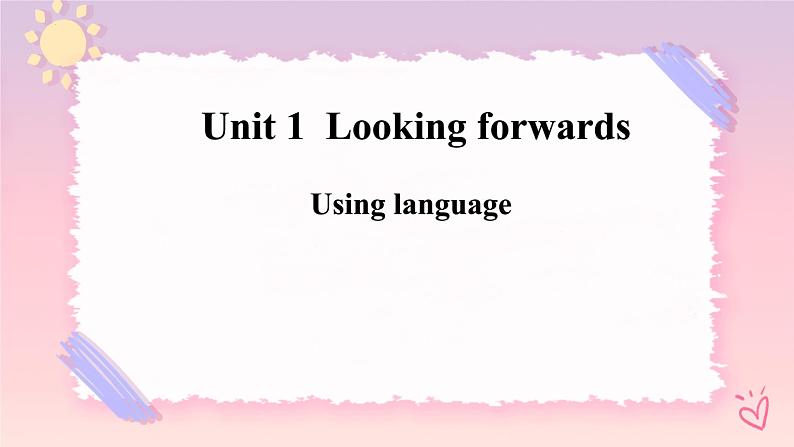







所属成套资源:新外研版英语选择性必修第四册PPT课件整套
高中英语外研版 (2019)选择性必修 第四册Unit 1 Looking forwards优质课件ppt
展开
这是一份高中英语外研版 (2019)选择性必修 第四册Unit 1 Looking forwards优质课件ppt,共26页。PPT课件主要包含了III,Grammar,一般体,进行体,完成体,完成进行体,一般现在时,一般过去时,一般将来时,Homework等内容,欢迎下载使用。
Grammar — Review: tenses
Vcabulary building
Listening & speaking
Lk at the sentences frm the reading passage. Decide which tense each is in and match the tenses t what they describe.
1. An actin cmpleted in the past befre anther past actin.2. An actin r event taking place ver a particular perid in the future.3. An actin that happened in a perid f time up t the present.
4. An actin that started in the past and may still be ging n r have just stpped.5. An intended future actin r event as seen frm the past.6. An n-ging situatin at r arund a particular time in the past.
1. What ther tenses have yu learnt? Find examples in the reading passage.
①One mment, we are lying cmfrtably in bed, abut t fall int a deep sleep. ②... we find urselves wndering r even wrrying abut pssibly the mst imprtant issue f ur life③Althugh they shared the same ambitius and energetic apprach t life, ...
(Present Cntinuus)
(Present Simple)
(Past Simple )
2. What d these tenses describe?
Present Cntinuus: t talk abut actins happening nw r arund nw; t be used fr future arrangements
Present Simple: t be used fr habits, permanent situatins, and truth; t be used fr the future fr timetabled events, such as airplanes
Past Simple: t describe events in the past
1. 一般现在时的构成
一般现在时通常以动词原形表示,当主语是第三人称单数时,谓语一般由动词原形后加 -s 或 -es 构成。
2. 一般现在时的用法
①表示经常性、习惯性的动作或存在的状态,常与频度副词及表示现在的时间状语连用。
②表示主语目前的性格、特征、状态或能力等。
例如:He is a man f few wrds. 他是一个少言寡语的人。 She knws French and German besides English. 除了英语,她还会法语和德语。
③ 表示客观事实、普遍真理及自然现象,或用在格言中。
例如:The earth ges arund the sun. 地球绕着太阳转。 Failure is the mther f success. 失败是成功之母。
④ 表示按规定、计划、安排、时间表等马上要发生的事情,常与具体的时间状语连用。该用法常用于火车时刻表、飞机航班时刻表,以及电影开演、作息、安排等时刻表上,且仅限于少数表示短暂意义的动词。
例:The train leaves at 4:30 p.m. 火车在下午4:30出发。 The plane takes ff at 5 ’clck. 飞机在5点钟起飞。
1. 一般过去时的构成
一般过去时由动词的过去式表示。
2. 一般过去时的用法
① 表示过去某一时间发生的动作或存在的状态,其中包括过去的习惯性动作,常与表示过去的时间状语连用。
② 描述过去时间内连续发生的动作。
例如:He pened his eyes, put n his clthes quickly and jumped dwn frm the bed. 他睁开眼睛,迅速地穿上衣服,并从床上跳了下来。
例如:I didn’t knw yu were here. 我不知道你在这里。
③有些动作发生的时间没有具体表明,但实际上是“刚才,刚刚” 发生,应使用一般过去时。如 I didn’t knw ... 或 I frgt ... 等表示事先或说话之前不知道或不记得,但现在已知道或记得的事情。
一般将来时的构成和用法
①表示将要发生的动作或将来存在的状态,shall 一般用于第一人称,will 可用于各种人称,常与表示将来的时间状语连用。
1. will / shall + 动词原形
②will 还可表示说话时临时作出的决定。
例如:— Shall I rder a taxi fr Sarah t g t the airprt tnight? — Dn’t bther. I’ll drive her there.
表示按计划、打算要做某事;还可表示“预见”,即某种迹象预示着要发生某事。
2. be ging t + 动词原形
例如:Whether in the hme r the wrkplace, scial rbts are ging t becme a lt mre cmmn in the next few years. 无论是在家里还是在工作场所,未来的几年里社交机器人将会变得更加普遍。
表示按计划、约定或按职责、义务必须做的事或即将发生的动作。
3. be t + 动词原形
例如:The highway is t be pened in May. 这条高速公路将在5月份开放。 Yu are t hand in yur papers by 10 ’clck. 10点前你们得上交论文。
表示立即要发生的动作,常译作“即将……;马上就……”,通常不与具体的时间状语连用。
4. be abut t + 动词原形
例如:Wrk was abut t start n a new factry building. 新厂房即将动工。
相关课件
这是一份高中英语Unit 1 Looking forwards教案配套课件ppt,共60页。PPT课件主要包含了Grammar, 一般现在时, 一般过去时, 一般将来时, 过去将来时, 现在进行时, 过去进行时, 将来进行时, 现在完成时, 过去完成时等内容,欢迎下载使用。
这是一份人教版 (2019)选择性必修 第一册Unit 2 Looking into the Future优质课件ppt,共60页。PPT课件主要包含了Signposts等内容,欢迎下载使用。
这是一份高中英语人教版 (2019)选择性必修 第一册Unit 2 Looking into the Future精品ppt课件,共32页。PPT课件主要包含了Grammar等内容,欢迎下载使用。










